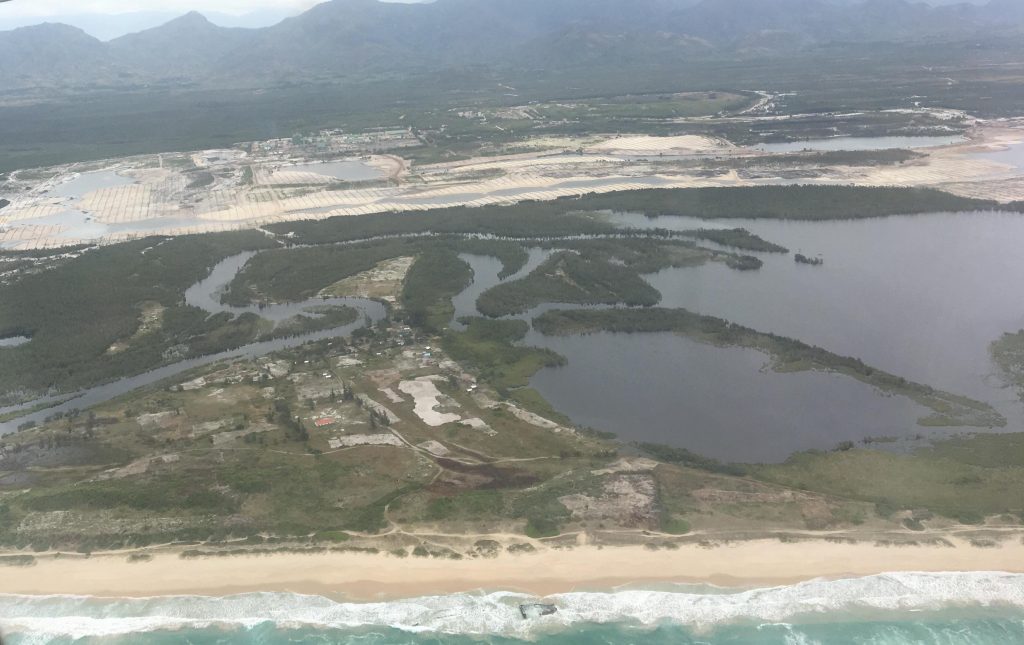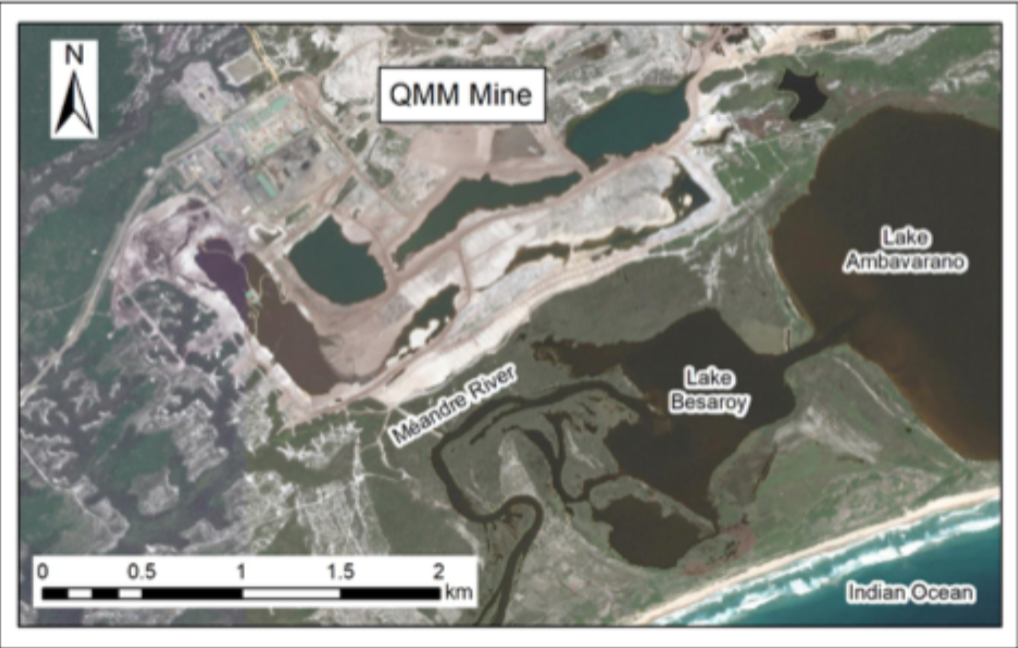
The Andrew Lees Trust 2020 Water Briefing on the QMM mine buffer zone breach and water contamination issues is now available
DOWNLOAD THE WATER BRIEFING HERE
Between 2013-2014, Rio Tinto’s mine in Madagascar, operated by subsidiary QIT Minerals Madagascar (QMM), exceeded its authorised permissions in the Anosy region in southeast Madagascar where the mine extracts ilmenite, an ingredient of industrial whiteners. QMM breached an environmental buffer zone designed to protect local waterways, and encroached onto the bed of the adjacent Lake Besaroy in an estuary where local people fish, gather their drinking water and emergency food supplies.
A key concern arising from the QMM breach has been the health risks related to the discharge of QMM mine wastewaters containing concentrations of radionuclides (uranium and thorium) and heavy metals (lead) well above WHO guidelines for safe drinking water.
As part of its advocacy work, the Andrew Lees Trust (ALT UK) has produced a Water Briefing to bring together in one place the key findings from independent hydrology and radioactivity studies, which it commissioned as part of its research into the QMM buffer zone breach and QMM impacts on regional water quality.
The Briefing includes broader human rights and environmental governance themes which are not explored in the expert’s studies, but which are pertinent and may help frame discussions about the concerns arising and what and who might be involved to address them.
The ALT UK Water Briefing is not exhaustive on the subject matter, nor is it designed to present all the views of Rio Tinto; it cannot cover all the technical aspects of the exchange between ALT UK and the mining company in detail. However, ALT UK is able to provide the relevant documentation to support and substantiate statements, as necessary.
After more than three years of research and advocacy, ALT UK and collaborating NGOs continue to lobby the mining corporation Rio Tinto to address water contamination related to the activity of QMM in Anosy region – in particular to demand the provision of safe drinking water to communities living around the mine.
To access all the relevant studies see here
To access media articles see here
To read related blogs visit here
KEY ISSUES IN SUMMARY
Violating the environment
- In the waterways of Mandena where local people fish and gather their drinking water, the QMM mine is discharging its process waters from ilmenite and monazite extraction. Additionally, lakes and waterways adjacent to the mine are only protected against seepage or overflow of mine wastewaters from the QMM mining basin by a dam of stacked mine tailings made of reject sands (tailings).
- Despite the company’s public assurances that it is managing its mine tailing facilities to the highest standards, the QMM ‘berm’ (or dam) structure was found to have breached permitted buffer zone limits by at least 90 metres in places and entered the adjacent lake (Emerman, 2018; Ozius, 2018; Rio Tinto, 2019).
- The breach raised concerns about possible toxic impacts on the waterways and lakes. A review of the radioactivity of the Rio Tinto QMM mine by Dr Stella Swanson (2019) identified elevated levels of uranium in the waters surrounding the QMM mine 50 times higher than the WHO guidelines for drinking water in some places.
- Elevated levels of uranium are a serious concern because they can create health risks. Exposure to high levels of uranium in drinking water for a long time could affect kidneys and bones (Health Canada, 2019). Young children, infants and foetuses are particularly vulnerable to exposure from lead contamination.
Water contamination related to QMM activity
- To address Rio Tinto’s claims that the uranium levels in waters around QMM operations were all naturally occurring, ALT UK advanced additional studies.
- Mineral sands in the region of Anosy have unusually high background radiation. However, it is a common occurrence for radionuclides such as uranium present in mineral sands to be concentrated by the extraction process, and to levels that are “problematic” (WHO 2011). Swanson explains “while uranium naturally occurs in the ore, once the ore is dug up and processed, uranium is released into the water in larger quantities than if it was left in place on the ground”.
- Swanson reviewed the QMM data (August Memo, 2019) and found elevated uranium in the QMM mining pond, as high as 1.9mg/L, and concludes “The QMM mine definitely releases more uranium into water on the site, thus creating an enhanced source of uranium to the Mandromondromotra River and Lac Ambavarano” (Swanson Memo, 2019).
- To further explore the source of elevated uranium, water samples were collected by local residents/researchers from sources downstream and upstream of the QMM mine site in 2019. These were sent to a US lab and tested. The results analysed by expert hydrologist, Dr Emerman, demonstrated “a detrimental impact of the mine on regional water quality, indicated by the increases in uranium, thorium and lead in surface water from the upstream to the downstream side of the mine, which are statistically significant at better than the 99% confidence level” (Emerman, 2019).
- The studies by Swanson and Emerman demonstrate surface and groundwater discharges from the QMM mine have resulted in increases in uranium, thorium and lead in surface water from the upstream to the downstream side of the mine. Both have called for the immediate provision of safe drinking water for communities.

Failures to act
- At their AGMs in 2019 and AGM 2020 Rio Tinto has denied any relationship between QMM’s mine and uranium levels in adjacent lakes and waterways; the company claims that the uranium levels are consistent with naturally occurring radioactive material (NORM) in this region; they also claim that the QMM extraction process does not involve any chemicals (which is irrelevant) or change anything in the natural environment and there are no health impacts. They have not been able to provide any evidence to substantiate these claims.
- There are no available health studies that demonstrate monitoring of health impacts from the mine in the region. While there has yet to be an in-depth health study, available indicators are significant enough to require action e.g. given uranium concentrations are as high as 1 mg/L in Lac Ambavarano near the weir, alternative safe drinking water must be provided.
- Rio Tinto acknowledges that its “process water may have higher concentrations of minerals and metals than deemed safe by drinking water standards”‘. (Rio Tinto, letter Feb 2020)
- Rio Tinto’s explanations of QMM’s wastewater management process are not in themselves evidence that the “settling time” provided by the holding pond system prior to release of wastewater from the mining site into the surrounding environment is successfully addressing contamination issues (ibid).
- Rio Tinto/QMM is unable to provide evidence that levels of uranium and heavy metals in wastewaters leaving the QMM site into adjacent wetlands and streams are “under permitted limits” or are “safe to the community and the environment” (ibid).
- Rio Tinto has attempted to publicly assuage concerns about the QMM buffer zone breach and the uranium levels by quoting the government regulator, the Office Nationale pour L’Environnement (ONE), who they claim has deemed the impact of the QMM buffer zone breach to be “negligible”. However, neither the ONE nor the company have been able to provide any evidence for the basis of such a status, e.g. technical surveys/reports.
- Swanson criticised QMM’s monitoring of radionuclides for ingestion pathways e.g. via water, food, and soil, as “unacceptable”. Rio Tinto has advanced radioactivity research only after issues were raised by ALT UK at the Rio Tinto AGM in 2017, and in 2019 following Swanson’s review. However, if earlier reports had been acted upon, QMM would have advanced “expected” further studies some six years previously, based on a World Bank report that flagged “measurements that indicate a higher level of radioactivity in areas that have been mined” (World Bank PIC IAP, 2014).
Call to action
- Following the release of ALT UK’s water studies in December 2019, Malagasy civil society platforms have demanded an investigation and an audit of the QMM social and environmental issues.
- Andrew Lees Trust (ALT UK), Publish What You Pay (PWYP UK and Madagascar) and Friends of the Earth (England Wales and N Ireland) have lobbied for urgent action by Rio Tinto to 1) provide safe drinking water to communities 2) manage QMM wastewaters 3) improve transparency around environmental monitoring and 4) ensure an open and inclusive communications campaign to educate and inform local people.
- 10 Malagasy CSOs and 20 international supporters have signed a letter to the Government of Madagascar to review arrangements between the mining company and the environmental regulator, the National Office for the Environment (ONE) to improve environmental monitoring and transparency around the mine.
https://theecologist.org/2020/apr/07/true-cost-rio-tinto-dividends
Necessity to acknowledge and act
- A key action required under WHO guidelines is the provision of alternative sources of safe drinking water (WHO 2011) for the communities affected. Approximately 15,000 people are situated close to the Mandena mine site and are affected by its impact on the immediate environment. They rely on rivers and lakes around the QMM mine for their drinking water, food security and survival.
- Provision of Safe drinking water requires Rio Tinto/QMM to accept that management of the risk associated with QMM mine-related uranium concentrations in receiving waters is a priority (Swanson, 2019).
- Rio Tinto corporate and sustainability pledges demand the company recognise the multiple benefits of the provision of safe drinking water to nearby communities in accordance with its commitment to the management of human rights risks, including risks to water resources, and to directing benefits to those affected by mining activities.
- Rio Tinto needs to ensure equitable inclusion of local stakeholders and affected communities. This includes developing local staff and community capabilities in communications, social engagement and environmental monitoring skills in order to increase understanding among community members, contribute to informed and inclusive decision making, and provide independent monitoring of the mine’s radiation levels, water quality and other environmental impacts over the project lifetime, and beyond.
see all at www.andrewleestrust.org/advocacy.html

Pingback: Three AGMs and a global pandemic - London Mining Network